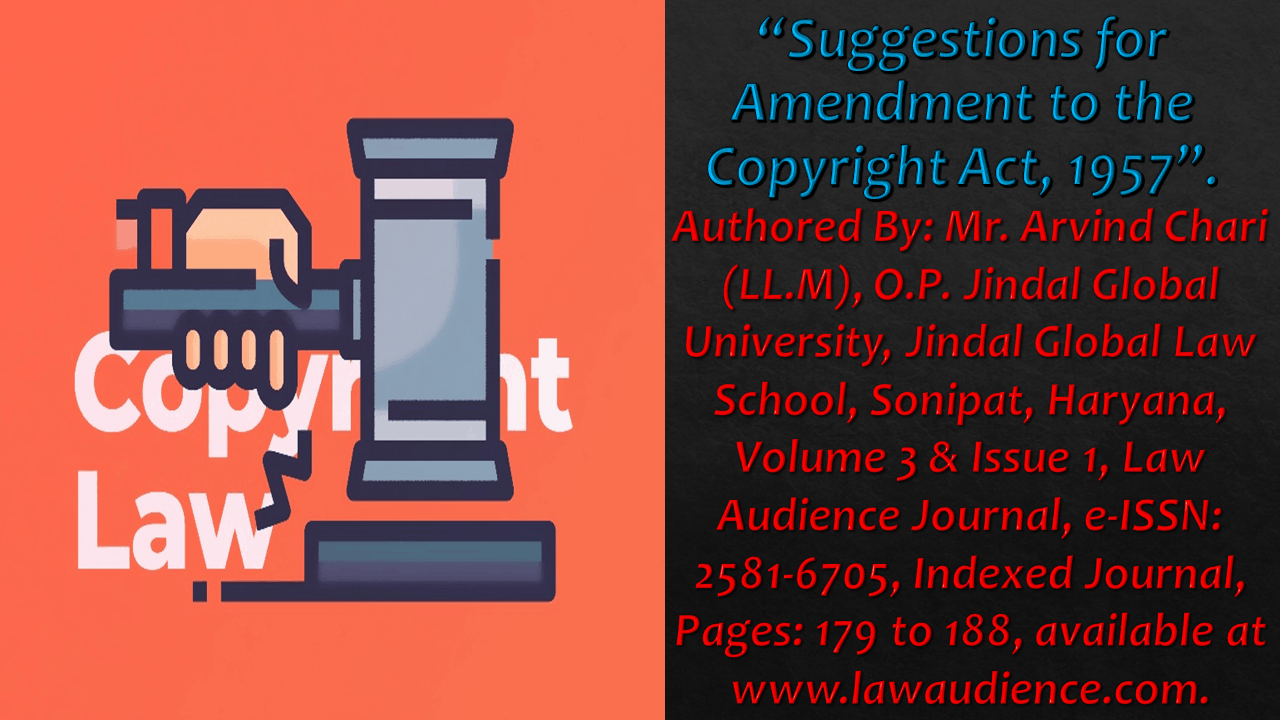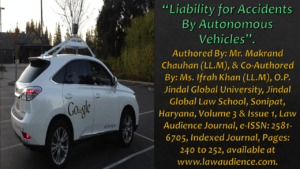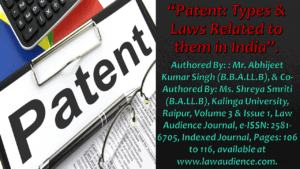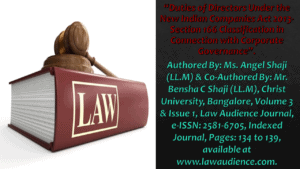Click here to download the full paper (PDF)
Authored By: Mr. Arvind Chari (LL.M), O.P. Jindal Global University, Jindal Global Law School, Sonipat, Haryana,
Click here for Copyright Policy.
I. INTRODUCTION:
Copyright is a bundle of rights which is given to the creators of literary, dramatic or musical work; artistic work; and the producers of cinematograph film and sound recording. Copyright is often termed as a property which primarily consists in intangible rights.[1] The term “Copyright” has been defined under Section 14 of the Copyright Act 1957 (hereinafter to be referred as “Act”) as an exclusive right subject to the provisions of this Act, to do or authorize the doing of the acts in respect of a work or any substantial part thereof, and to exclusively exercise various other rights granted to him by law. On various occasions, the Act was amended namely in the year 1983, 1984, 1992, 1994 and 1999. However, the most recent one being the Copyright (Amendment) Act, 2012, which came into effect from 7th June 2012, brought significant changes to the provisions of the Act in accordance with the WIPO Copyright Treaty, 1996 and WIPO Performances and Phonograms Treaty 1996.
Recently, on 14th October 2020, the Registrar of the Copyright Office of the Department for Promotion of Industry and Internal Trade (hereinafter to be referred as “DPIIT”) sought for the stakeholders’ feedback or suggestion on as to “whether there is a need for the amendment in the Copyright Act, 1957?” The DPIIT had granted time till 30th December 2020 to furnish comments or suggestions to the above mentioned. Vide this research paper, I would try to bring out the suggestions which would enable to clear out the ambiguity in the Act and its corresponding rules i.e., Copyright Rules, 2013 (hereinafter to be referred as “Rules).
II. RECOMMENDATIONS FOR THE AMENDMENT OF THE COPYRIGHT ACT, 1957:
The Act definitely requires various additions which will make the Act digital ready to unlock the creative opportunities presented to by emerging digital technologies. The recommendations and suggestion are listed out herein below:
II.I HARMONIZATION OF THE ACT WITH THE INFORMATION TECHNOLOGY ACT, 2008 VIS-À-VIS SAFE HARBOUR:
The definition of the term “Intermediary” is one such addition. It is pertinent to mention that the said definition should be in line of the definition enshrined under Section 2(1)(w) of the Information Technology Act, 2008 (hereinafter to be referred as “IT Act”). Further, there is always a confusion whether in case of any copyright infringement, can an intermediary enjoy the safe harbour provision enshrined under Section 79(1) of the IT Act. To answer this confusion, the Hon’ble Delhi High Court has observed that irrespective of any other law, an intermediary is guaranteed a safe harbour and the only restriction is when the intermediary fails to fulfill the condition enshrined under Section 79(2) and 79(3) of the IT Act.[2] Having said that, irrespective of the said judicial interpretation, it is suggested that the Act should make a special reference that the safe harbour provision granted under Section 79 of the IT Act can also be availed under the Act.[3]
II.II AMENDMENT OF SECTION 33 OF THE ACT:
Section 33 of the Act states that sound recording in respect of films may only be licensed to a third party by a Copyright Society. Further, it empowers the owner of the copyright to grant licenses consistent with his obligations as a member of the registered copyright society. The said section lacks clarity as it fails to determine that only a registered copyright society is empowered to issue and grant license. On various occasions, several private parties have been found issuing licenses directly without being registered as a copyright society and have benefited through such issuances. Such private parties have also started to file copyright infringement case in their own name even though they are not the owner of the copyrighted work. Therefore, it is recommended that the Act should clarify that only the registered Copyright Society is empowered to grant and issue license.
II.III AMENDMENT OF SECTION 31D OF THE ACT:
Section 31D of the Act talks about any broadcasting organization which is desirous of communicating to the public is entitled to procure statutory license under Section 31D of the Act. Before the emergence of the Internet broadcasting organisations such as OTT, Online Music Service Provider; TV and Radio used to and are only entitled to procure statutory license for the broadcasting of the copyrighted work. Pursuant to the emergence of the above-mentioned organisations, the Ministry of Commerce and Industry vide the office memorandum dated 5th September, 2016 clarified that the words “any broadcasting organization desirous of communicating to the public” cannot be restricted to only radio and television broadcasting as in simpler terms, the definition of the term “Broadcast” read with “communication to the public” tries to communicate that the copyrighted content should be made available or disseminated to each and every household regardless of the mode of transmission. Ergo, the Ministry clarified that the Internet Broadcasting Organisations cannot be restrained from procuring the statutory licenses under Section 31D of the Act.
Even after the issuance of the said memorandum which clarified the conundrum, the Hon’ble Bombay High Court stated that Section 31D of the Act was restricted to only radio and television broadcasting.[4] Therefore, in view of the above said, it is suggested that given the opportunity, the entire provisions with regards to the statutory licensing needs to be revisited keeping in mind the emergence of the new players in the market and in view of the above-mentioned contentions.
II.IV MISUSE OR ABUSE OF JOHN DOE OR DYNAMIC INJUNCTION:
John Doe order is a remedy which is provided to protect the intellectual property from being infringed. Vide the said order, the plaintiff is permitted to search and seize the evidence from the premises of the unidentifiable infringer. Over the years, these orders have been modified and led to placing of wider powers in to the hands of the plaintiffs or the right owners. Recently, the Hon’ble Delhi High Court coined a modified version of the John Doe order known as Dynamic Injunctions.[5] The said mechanism keeps on extending the existing injunction in case of resurfacing of a new infringing website. In order to extend the existing injunction order, the plaintiff can, instead of filing a fresh suit, approach the Joint Registrar of the concerned High Court. Undoubtedly, this mechanism saves a lot of time of the courts in India which are already burdened with several pending cases. But at the same time, there is a likelihood of the said mechanism being misused or abused by the right holder or the plaintiff. The Hon’ble Court in the said case sets the threshold to determine what constitutes a ‘rouge websites’. Therefore, it is highly recommended that the Act should determine under what circumstances the John Doe or Dynamic Injunction should be granted and should set the threshold to determine the rogue websites which would restrict its abuse and misuse.
II.V DECRIMINALISATION OF THE COPYRIGHT INFRINGEMENT:
Chapter XIII of the Act deals with the criminal offences of infringement of Copyright or other rights conferred by this Act.[6] The criminal provision enshrined under the Act provide for penal consequences of the copyright infringement. It is pertinent to note that the Copyright is a right which prescribes third parties from exercising certain rights by virtue of giving exclusive rights to the owner of the copyrighted work. In case of any infringement, the owner of the copyrighted work will most likely look for recovering the losses incurred due to the said infringement.
Further, it is pertinent to note that the penalties also include for non-commercial use of works. There can be individuals who may have infringed without any profit-making motive. Imprisoning such innocent individuals could be harsh. In most cases, innocent infringers are punished which is excessive and disproportionate to the gravity of the crime committed. In other words, it is accentuated that the civil remedies available in the form of damages, rendition of accounts of profit, injunctions etc. are more than sufficient to tackle the copyright infringement. Therefore, it is suggested that the civil remedies would serve better in case of copyright infringement and accordingly, it is highly recommended that the criminal remedy should be removed.
II.VI PROVISO NO. 2 UNDER SECTION 18 OF THE ACT:
Proviso No. 2 enshrined under Section 18 of the Act reads as follows:
“Provided further that no such assignment shall be applied to any medium or mode of exploitation of the work which did not exist or was not in commercial use at the time when the assignment was made, unless the assignment specifically referred to such medium or mode of exploitation of the work:”
It is stated that the medium and mode of exploitation of the work must be mentioned on the assignment deed. Absence of the new medium and mode of exploitation of the work means that the assignment will not be considered to the extent to such mode. The said proviso has a serious implication on the assignee. Even after paying adequate consideration to acquire rights, title and interest in the copyrighted work, the assignee is facing the brunt. Therefore, it is recommended that there should be an amendment wherein there should be no mandatory requirement of explicit mention of the medium and mode of the exploitation of the work in the assignment deed.
II.VII STRENGTHENING THE ADJUDICATORY MECHANISM AND EFFICIENT ADMINISTRATION OF THE COPYRIGHT OFFICE:
The Act empowers the Registrar of Copyrights to perform all the administrative function of the Copyright Boards.[7] Instead, it is recommended that the Act should give adjudicatory powers to settle the disputes to the Registrar of the Copyrights and shall extend the power of the Intellectual Property Appellate Board (hereinafter to be referred as “IPAB”) by granting powers to hear the appeals against the orders of the Registrar of Copyrights.
Further, there should be an amendment with an aim of modernising the Copyright Office by facilitating online registration and access to records which will make the process expeditious and efficient as possible. Accordingly, it is hereby recommended that the policymakers should look to digitalise and modernise the copyright office which will make it more conducive to the current digital era. It is further, suggested that the policymakers should take statutes of other major jurisdictions such as Music Modernisation Act (hereinafter to be referred as “MMA”) of United States of America as an example which enabled the US Copyright regime to become more propitious to the digital era.
II.VIII RECOGNITION OF PARALLEL IMPORTING:
Parallel importing is a recognized concept which is highly recognized and applied in major jurisdictions such as member states of European Union, United States of America, Australia, etc. Parallel import means importation of genuine products without authorization of IP right holders. The practice of parallel import is based on the principle of exhaustion wherein the exclusive rights of the holder is ceased over the further sale of his goods once he has made a valid transaction of sale. There are three types of principle of exhaustion namely a) International Exhaustion, b) Regional Exhaustion and lastly c) National Exhaustion.
Even though, the Act does not recognize the concept of parallel import, the Hon’ble Delhi High Court has observed that in India parallel import is recognized and follows the concept of international exhaustion.[8] Unfortunately, the above mentioned is not explicitly recognized or captured in the Act or in other Indian statutes. On various occasions, vide the Copyright Amendment Bill 2010, the Government of India recommended the inclusion of the said concept. Further, the Joint Parliamentary Committee also recommended for its inclusion. Unfortunately, the concept failed to make the cut to the Act. In fact, in 2014, the Ministry of Human Resource Development (MHRD) vide a report recommended that parallel import should be permitted by listing out its benefits.[9] Therefore, based on the above said, it is suggested that the policy makers must explicitly recognize the concept of parallel import under the Act.
II.IX FAIR USE OF COPYRIGHT:
Fair use is an exception to the rights granted to the owner of the copyrighted work and allows limited use of the copyrighted material without acquiring permission from the right holder. Section 52 of the Act talks about certain acts which would not constitute a copyright infringement.[10] The Copyright (Amendment) Act, 2012 introduced certain fair use provisions to exempt intermediaries from liability in certain specific situations and provides them the opportunity to take down infringing content when brought to their notice. The Copyright (Amendment) Act, 2012 gives expression to the model of ‘fair use’ through Section 52(1)(b) and (c), which read as follows[11]:
“52. Certain acts not to be infringement of copyright – (1) The following acts shall not amount to infringement of copyright, namely:
(b) the transient or incidental storage of a work or performance purely in the technical process of electronic communication to the public.
(c) “transient or incidental storage of a work or performance for the purpose of providing electronic links, access or integration, where such links, access or integration has not been expressly prohibited by the right holder, unless the person responsible is aware or has reasonable grounds for believing that such storage is of an infringing copy…….”.
It appears that the purpose behind inclusion of sub-clause (b) was to exempt liability arising out of caching, in line with the international practice. The purpose behind inclusion of sub-clause (c) was to offer safe harbour exemption for internet service providers. However deliberate storing of works or with knowledge that such transient or incidental storage of works amount to infringement would still be problematic. While the exemption under Section 52(1)(c) is not applicable in situations where the person providing electronic links, access or integration is aware or has reasonable grounds to believe that such storage is of an infringing copy, this language is missing in Section 52(1)(b). It is imperative that the exception to infringement under Section 52(1)(b) is not misused in situations where the person/entity providing transient or incidental storage is aware or has reason to believe that such transient or incidental storage is of an infringing copy. This will also be in line with the safe harbor provisions of the Information Technology Act, 2000 read with the Information Technology (Intermediary Guidelines) Rules, 2011.
II.X AMENDMENT OF SECTION 19(9) OF THE ACT:
“19(9) No assignment of copyright in any work to make a cinematograph film shall affect the right of the author of the work to claim an equal share of royalties and consideration payable in case of utilization of the work in any form other than for the communication to the public of the work, along with the cinematograph film in a cinema hall.”
On perusal of the above-mentioned provision, it seems to be ambiguous as there is no clear mention of what constitutes to be the equal share of royalties and who all are to be considered as the recipient of the said royalties.
In furtherance, the provision fails to create a level playing field between cinematography films released on a cinema hall and those screened on digital platform vis-à-vis the royalty. Therefore, in view of the abovesaid, it is recommended that vide the amendment of the Act, policymakers should define the equal share and the recipient of the royalties. Further, the amendment should try to create a level playing field by extending the provision and exception provided to cinematograph films screened in a cinema hall and screened in a digital platform vis-à-vis the royalty.
II.XI AMEND THE ACT TO STEP IN LINE WITH EMERGING TECHNOLOGIES:
There is no protection for the work created by Artificial Intelligence (hereinafter to be referred as “AI”) without the interference of Humans. Emerging technologies such as AI and Machine Learning (hereinafter to be referred as ‘ML’) bring with them opportunities in monetization of copyright works as well as challenges in its protection. The Act must be amended to address gaps in copyright protection without compromising technologies ability to advance and unlock copyright’s growth.
II.XII RECOGNITION OF BROADCAST AS A COPYRIGHTABLE WORK:
The European Union (hereinafter to be referred as “EU”) law and the UK Act recognize ‘broadcasts’ as a work in which copyright subsists. Broadcasts are given equal rights in law. Under the UK Act, the author of a broadcast is the person ‘making the broadcast’.[12] Further, under the UK Act, an owner of the copyright in broadcast has the following exclusive rights with respect to his work:
- to copy the work[13];
- to issue copies of the work to the public[14];
- to show or play the work in public[15];
- to communicate the work to the public[16];
Further, under the EU Council Directive 92/100/EEC (hereinafter to be referred as “EU Directive”), ‘broadcasting organizations’ are granted the exclusive right to authorize or prohibit the fixation of their broadcasts, whether these broadcasts are transmitted by wire or over the air, including by cable or satellite. Cable distributors are specifically excluded from holding the right to broadcast where they are merely engaged in transmission of the broadcasts of broadcasting organization. The EU Directive also grants the broadcasting organizations the exclusive right to authorize/prohibit the direct or indirect reproduction/distribution of fixation of their broadcasts.
Unlike the above-mentioned jurisdictions, the Act do not recognise broadcast as a copyrightable work. Given the changes in broadcast technologies and challenges arising from piracy it is imperative that India recognize ‘broadcast’ as a copyrightable work (akin to a cinematograph film or sound recording) and ‘broadcasting organizations’ as authors of the work.
III. CONCLUSION:
The Government of India introduced the National Intellectual Property Right (IPR) Policy, 2016 (hereinafter to be referred as “NPR”) which came into effect on 12th May 2016 with an aim to sustain entrepreneurship by balancing the Intellectual Property Rights system, especially copyright law, in India.
It is pertinent to note that the usage of mobile phones has skyrocketed which means that every Indian is a potential creator or consumer of the copyrighted work. It could be stated that the Act is still not entirely in compliance with the NPR.
Therefore, it is hereby concluded that India needs digital-ready Copyright law to unlock the creative opportunities presented to by emerging digital technologies.
Footnotes:
[1] Cross town v. Rive, 2011 FSR 133
[2] Myspace Inc. v. Super Cassettes Industries Ltd. CS (OS) No. 2682/2008 in the High Court of Delhi at New Delhi.
[3] Joshi, Divij (2019): Indian Intermediary Liability Regime, Compliance with the Manila Principles on Intermediary Liability
[4] Tips Industries Ltd. v. Wynk Music Ltd. [Notice of Motion (L) No. 197 of 2018 in Commercial Suit IP (L) No. 114 of 2018]
[5] UTV Software Communication Ltd. v. 1337x.to & Ors., 2019 SCC OnLineDel 8002
[6] Section 63-70 of the Copyright Act, 1957
[7] Section 10 of the Copyright Act
[8] Kapil Wadhwa v. Samsung Electronics [2013 (53) PTC 112 (Del.)]
[9] The Impact of Parallel Imports of Books, Films / Music and Software on the Indian Economy with Special Reference to Students, NCAER, 2014 <http://copyright.gov.in/documents/parallel_imports_report.pdf>
[10] Academy of General Education v. Manini Malya, 2009 (39) PTC 393 (SC)
[11] Ananth Padmanabhan, Give Me My Space and Take Down His, accessible at:
http://www.ijlt.in/archive/volume9/Ananth%20Padmanabhan.pdf
[12] Section 9 (2)(b) of the UK Act
[13] Section 17 of the UK Act
[14] Section 18 of the UK Act
[15] Section 19 of the UK Act
[16] Section 20 of the UK Act
Cite this article as:
Mr. Arvind Chari, Suggestions for Amendment to the Copyright Act, 1957, Vol.3 & Issue 1, Law Audience Journal, Pages 179 to 188 (17th June 2021), available at https://www.lawaudience.com/suggestions-for-amendment-to-the-copyright-act-1957/.



